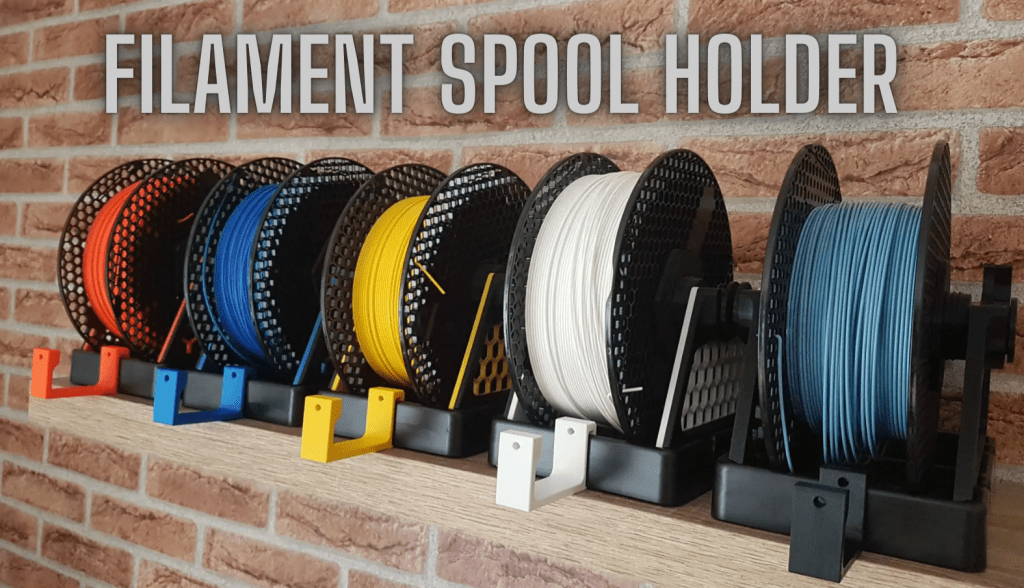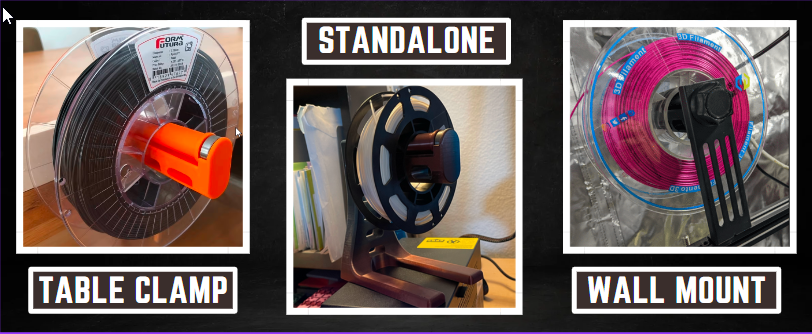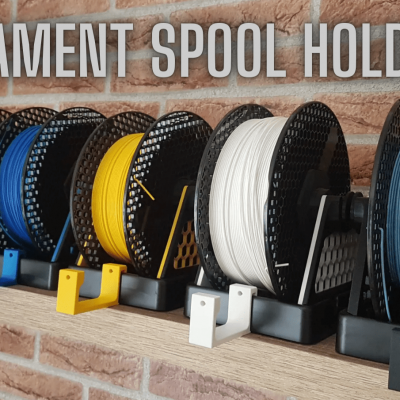
Filament is the fuel of a 3D printer. And just like you need a gas tank for a car, you need a filament spool holder for a 3D printer.
Today, basically all 3D printers have built-in spool holders. However, in all honesty, they usually suck, especially the ones on budget 3D printers like the Ender 3.
And, while it might not seem like a big deal, filament spool holders are actually pretty important on a 3D printer. For example, if not designed right, a spool holder can cause resistance from the filament getting to the hot end, leading to problems like under extrusion. Some filament spool holders also can’t fit certain filament spools, making printing these filaments much more difficult.
For the best 3D printer filament spool holder, I recommend the Prusa Gravity Spool Holder or a Simple Bearing Roller spool holder.
Want to hear about other options? Read on as we take a deep dive into the best 3D printer filament spool holders!
Table of Contents
What is a Spool Holder?
A filament spool holder is pretty self-explanatory, but it’s the piece of hardware that holds the filament spool. Spool holders prop the “O”-shaped filament spool off the ground so it can rotate freely and release more filament as it’s pulled by the extruder during a print job.
Spool holders are usually just cylindrical rods that spools rest on, but they can take other forms, too, as you’ll see throughout this article.
Best Spool Holders at A Glance
If you need a filament spool holder for your 3D printer or your current one is just causing issues, in the sections below, I’ve gone over some of the best spool holder options around.
And you’ll be happy to know that most of these options will cost you almost nothing as they can be almost entirely 3D printed!
1. Simple Bearing Roller
First up, we have the Simple Bearing Roller spool holder. These types of spool holders use bearings to allow a spool to spin in place, releasing filament as the print job progresses.
A typical bearing roller filament spool holder is split into two assemblies, each with two skateboard bearings and rims that surround them. The sides of the spool go in between the rims and rest on the bearings. As such, when the extruder pulls the filament, the spool rotates freely on the bearing but doesn’t move due to the rims.
Because there are two assemblies, this type of filament spool holder can typically work on any filament spool because you can make the spacing between the two assemblies whatever you want.
Lastly, it’s important to note that this type of spool holder can go either to the side or above your 3D printer’s extruder, making it even more compatible with different 3D printer setups.
Two great options for this simple bearing roller spool holder include the TUSH, a free 3D printable option, and a similar purchasable product from Befenybay that you can buy on Amazon for very little!
2. 3D Printable Hanger
Most of the stock spool holders on 3D printers are just cylindrical rods that prop up a filament spool. While this works, the weight of the filament causes a lot of instability across the frame of the printer. A better idea is to hang the spools above the printer so that they’re not touching the machine at all.
You can do this by either hanging a rod from your ceiling or mounting rod holders to a table (or another surface). Then, all you need to do is lift the rod off the mount and slide as many filament spools as you want on it. Additionally, you can use specialized spool hooks to hang on the rod, such as this 3D printable option.
I actually use this type of holder for my own setup. I made it using a chopped-in-half curtain rod and two 3D printed rod holders I designed, which I screwed into the side of the table the 3D printers are resting on.
The only downside of a 3D printable hanger spool holder is that you need to use a strong rod (it can’t be 3D printed) so that the weight of the filament spools doesn’t break it.
So if you’ve got a whole print farm or even just a few printers on a table, I suggest going with this option because of how easy it is to make and how many spools you can fit.
3. Mega Anti-Tangle Roller
Next, the Mega Anti-Tangle Spool Holder is another 3D printable option. As the name of the project suggests, it’s meant to prevent your filament from tangling, which can be a very annoying problem to fix because tangled filament can cause your prints to fail.
The holder prevents tangles with its intuitive rolling system, which uses 3D printable rollers (with bearings inside) to prevent the filament strand from accidentally moving backward, which is what causes tangles.
Unfortunately, while this spool holder is super nice to have if you don’t like untangling filament, it’s a bit difficult to build. It uses over 23 3D printable pieces, as well as a handful of bearings and screws. Luckily, the designer has provided a lot of images of the spool holder that you can use as a reference for assembling it.
Another benefit of the Mega Anti-Tangle Roller is that it’s pretty wide, meaning it can fit many different filament spools.
I strongly suggest making your own Mega Anti-Tangle Roller filament holder if you want the smoothest printing experience and no tangles.
4. Prusa Gravity Spool Holder
The Prusa Gravity Spool Holder is another option, and it uses gravity to rewind the filament strand to prevent tangling and other issues.
The spool holder is entirely 3D printable, comprising over ten different models. And what’s amazing about this project is that, while the spool holder is a normal size, all of the 3D printable parts can fit on an Ender 3 (220 x 220 mm bed). This means you can make this spool holder on basically any normal 3D printer.
But the main feature of the Prusa Gravity Spool Holder is its intuitive auto-rewinding mechanism. Using an angled ratchet-like system, your spool will move up the gear rack component as filament is pulled. And, when there’s slack, the filament will roll back down so that the filament doesn’t hang loose and get tangled on anything.
As such, using this spool holder might eliminate your extrusion issues if they’re related to resistance from the filament spool.
It’s also worth mentioning that this spool holder looks super cool. With the Prusa-style hexagonal panels, the Gravity Spool Holder makes 3D printing look super sexy!
While the designer states that the spool holder is meant for a Prusa MMU2S device, it can work on any setup, no matter what printer you’re using. And don’t worry about building it because there’s a blown-up diagram on the project page that shows where each part goes.
So, if you want a high-end but completely free filament spool holder, definitely give the Prusa Gravity Holder a look!
5. Filler – Customizable Bearing Spool Holder
Next, the Filler is a filament spool holder that uses bearings to allow your inserted spool to roll super smoothly with very little resistance.
The actual Filler assembly is a simple 3D printable cylindrical rod with lips at both ends and bearing mounts. The lips ensure your inserted spool doesn’t fall off the holder, and the bearings provide super smooth motion for the spool.
But the reason I love the Filler isn’t the spool holder but the many mounting options that allow you to customize your 3D printer setup.
Moreover, the designer has provided a few different assemblies and structures that the Filler can attach to. For example, there’s a table clamp, a wall mount (screw-in), and a standalone holder.

On top of that, there are a handful of other mounts specifically designed to fit certain 3D printers. For example, the “Creality Brace” allows you to attach the Filler spool holder to basically any Creality printer, such as the Ender 3 or CR-10. Some other mounts work with printers like the Prusa i3, Ultimaker 2, and Anet A8.
And another benefit of the Filler, is that it’s super popular in the 3D printing community. As such, there have been many updates to the design to improve its functionality and expand what printers it’s compatible with. There are also a ton of comments explaining the relatively-easy assembly and installation process.
So, if you want a simple yet super effective spool holder, the Filler is a terrific option. It works on basically any 3D printer, giving you a lot of customization options, and its bearing rollers reduce the filament resistance to a minimum.
While it doesn’t have the most creative name, the Universal Auto Rewind Spool Holder is yet another amazing anti-tangle filament holder.
6. Universal Auto Rewind Spool Holder
The Universal Auto Rewind Spool Holder, as its name indicates, auto-rewinds the inserted filament. It does this through a 3D printed coil spring, which provides some counter-resistance to the filament spool’s rotations.
This pulls the filament spool back just the right amount so that the filament strand doesn’t tangle, but it also doesn’t create resistance for the extrusion process. In other words, it’s basically Goldilocks!
And, as an added bonus, the latest version of the Universal Auto Rewind Spool Holder has an adjustable clutch. This knob allows you to control the tension of the spring just in case there’s too much (extrusion resistance) or too little (tangling). The clutch also makes the spool holder look absolutely baller!
Besides the spring and coil, all of the other parts of this spool holder are 3D printed, meaning this option is completely free (only the cost of filament). In total, there are over 15 different parts used in the spool holder, but this number can change depending if you want to add a clutch. You also can opt to not use the spring if you don’t want the anti-tangle feature.
It’s also worth noting that this spool holder can fit most 1-kg filament spools. And you can adjust the width of the filament spool axle by rotating the axle knob so that it clasps the spool just the right amount.
Lastly, similar to the last option, there are many different mounting options and additional accessories for the Universal Auto Rewind Spool Holder. Moreover, many community members have designed mounts for this spool holder that allow you to attach it to tables, desks, and other places.
So, if you want a spool holder that’s completely 3D printable and provides the perfect mix between no tangles and no resistance, then the Universal Auto Rewind Spool Holder is the perfect option!
7. Classic
Lastly, we’ve got the classic filament spool holder. I included this option for any of you who just want a completely typical and standard spool holder for your 3D printer.
The Bilway filament rack has the same mount as the stock spool holder on the Creality Ender 3 and CR-10, with two T-nut screw holes that allow you to securely mount the assembly to any aluminum extrusion.
Additionally, this product has a single bearing on the inside to provide smoother filament rotations and reduce extrusion resistance.
I mean, I can’t recommend a completely normal spool holder; it just wouldn’t be good enough for you!
While you don’t get any auto-rewinding (anti-tangle) features from this spool holder, it should be a good bit stronger because it’s not 3D printed. Additionally, there’s basically no assembly required.
Sadly, this classic spool holder isn’t very compatible with different filament spools due to the un-adjustable width of the axle. However, a 5-kg version of the Bilway filament rack is available at the same low price if you want to print with Jumbo (Texas-sized) spools.
So, if you need a low-effort spool holder that’s a good bang for your buck and offers decent spool rotation smoothness than the Classic spool holder might be for you!
Conclusion
Overall, while it might not look important, the filament spool holder matters a lot on a 3D printer.
If you’re looking for the most simplistic option, the Classic spool holder is probably best because you don’t need to 3D print it. If you still want a simple option but don’t want to pay, the Simple Bearing Roller or 3D Printable Hanger are probably better choices as they are very easy to make and use almost all 3D printed parts.
Now, if you want the best 3D printer spool holder, then I strongly recommend the Prusa Gravity Spool Holder and Mega Anti-Tangle Roller. Both feature smartly-designed systems for preventing filament tangles while also reducing extrusion resistance to a minimum.
Enjoy!


